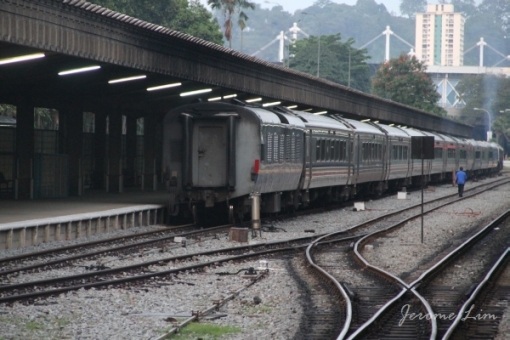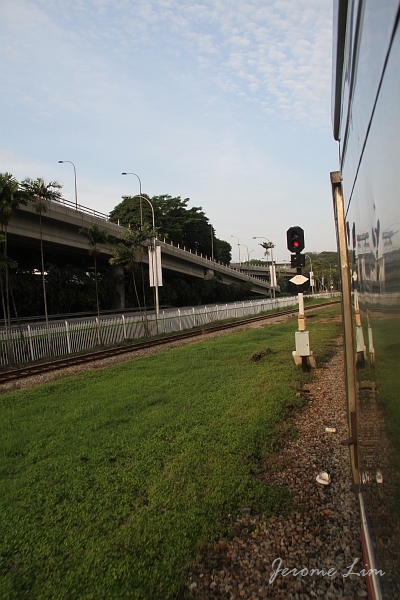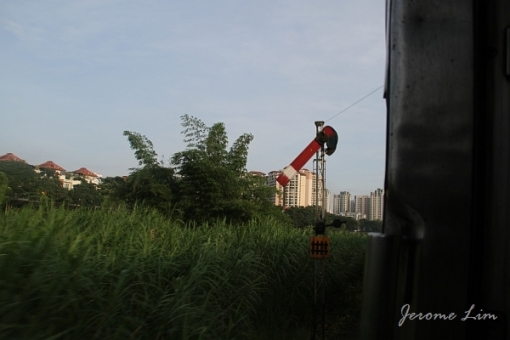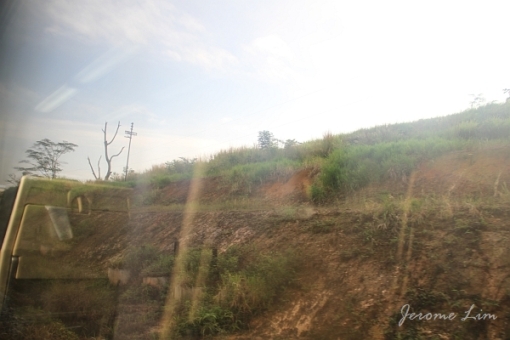Tanjong Pagar Railway Station began its life in the fourth decade of the 20th Century, opening with a promise that it was to have been the southern point of a rail network that was to span the continent of Asia and connect to the then well established European rail systems. The vision was an ambitious one, a link would not only be created between Europe and the Far East through the railway, but it would also have the potential to reach across the Pacific and Indian Oceans via sea routes, with Singapore – already then a well established port, serving as the principal gateway.
The first act of the station, was however not as a terminal for the carriage of goods or to see the rush of passengers through its main hall. With the station’s main building close to completion at the end of 1931, it provided a venue for a Manufacturers’ Exhibition that opened on 2nd January 1932.
The exhibition was the first of its kind in Singapore. Coming at a time when the world was still suffering from the effects of the Great Depression, the exhibition purpose was to bring to light Singapore’s hitherto unheard of manufacturing potential. Providing local manufacturers with a platform to showcase their products and capabilities, the exhibition also helped to promote Singapore’s growing importance as a economic centre in the British Far East – with the very grand looking new station as its centrepiece.
The exhibition’s aim, stated in the official guide, had been “to present as many aspects as possible of actual and potential manufacture in Singapore”. Included amongst the exhibitors were companies that were to become household names in Singapore including the likes of Robinsons, John Littles, Malaya Publishing House (which was to later become known as MPH), Diethelm and the Straits Trading Company. Opened by the then Governor of Singapore, Sir Cecil Clementi, the exhibition also provided many members of the public with their first view of the internals of the main building of the new station.

The main building of the station was first used as a venue for the first Singapore Manufacturers’ Exhibition which opened on 2nd January 1932 (image source: Willis’ Singapore Guide, 1936).
The actual opening of the station to railway traffic wasn’t until some months later on the 2nd of May 1932. This was commemorated with the arrival of a passenger train, the first to pull into Tanjong Pagar. As reported by the Straits Times on 3rd May 1932, it “comprised of an engine and three saloons to travel over the new deviation”. Leaving Bukit Panjang Station at 4.30 pm, it carried a load of guests including the Governor, the Sultan of Perak and Mr J Strachan, the General Manager of the FMSR and arrived “punctually at 5.15”.
In his speech at the opening, Sir Clementi was to explain the motivation for building of a station of such a stature, saying:
We stand here at the southernmost tip of the continent of Asia; and, since the Johore Strait is now spanned by a causeway which was opened for traffic on June 28, 1924, we may even say that we stand at the southernmost top of the mainland of Asia. This point is, therefore, a real terminus as well as a natural junction between land-borne and sea-borne traffic; and it is very right that the terminal station of the Malayan railway system should be built at Singapore, the gateway between the Pacific and Indian Oceans and immediately opposite the Tanjong Pagar docks, where every facility will be afforded for interchange between railway and ocean shipping.
The Governor also added that he had “not the slightest doubt that, for centuries, this Singapore terminal station will stand here as one of the most nodal points in the whole world’s scheme of communications.”
While this, eight decades later, has not quite come true (although we are still talking about a Pan-Asian rail network) for the station, there is little to dispute Singapore position as a transport and communications node in the modern sense. The Governor could not of course have predicted the phenomenal growth that air transportation was to see at that point in time.

The location of the station, across from the docks at Tanjong Pagar, was deliberately selected so that the southern terminal of the what would have been an intercontinental overland railway network could be integrated with ocean shipping and extend the reach over the Pacific and Indian Oceans (image source: Willis’ Singapore Guide, 1936).
The station, one of many of Swan and McLaren’s masterpieces, even in its current state of disrepair, is a wonderful piece of architecture to marvel at and was described by an article in the 7th May 1932 edition of the Malayan Saturday Post as having a “palatial appearance”. Overshadowed by the towering blocks that have come up at its vicinity,an elevated road, and buildings and containers stacked high at the docks it was meant to feed, it does however take a bit of effort to take in the station’s grand appearance.
A feature of the grand building that is very noticeable is the entrance arches,which are flanked by four triumphal figures. The work of sculptor Angelo Vannetti from the Raoul Bigazzi Studios Florence, they stand guard over all who pass through the arches and into the station’s grand vaulted hallway. Described as “lofty and cool” in the same article, the main hall extends three storeys or some 21.6 metres above the visitor, providing a “sufficient pocket of air” to allow the hall to be kept cool in what even then must have been the oppressive tropical heat. It is this lobby that impresses the most. Six sets of mosaic panels, designed to resemble batik paintings, catch the visitor’s attention immediately.

The main vaulted hall of the station in its early days. An impressive integration of architecture and public art. The lamps and the clock seen in this picture – has long since disappeared, but the hall remains, even in the state the station building is in today, a particularly impressive piece of architectural work. Caption reads ‘Booking Hall, Singapore Station’ (image source: Willis’ Singapore Guide, 1936).

There is a lot more clutter in the hall today … the lamps and the clock we see in the hall in the station’s early days are also missing.
The Willis’ Singapore Guide (1936), gives us an idea of Tanjong Pagar and the operations of the FMS Railway from the station in and around the time of the station’s opening. It describes the FMSR as running from Singapore for 580 miles to Padang Besar. There it meets the Royal State Railways of Siam.The FMSR also incorporated a 121¼ miles of the Johore State Railway, which was leased to it.
As is the case today, the East Coast Line branched off at Gemas and extended to the port of Tumpat some 465 miles from Singapore. A short branch line connected the line there with the Siamese Railways at Sungei Golok.
We are also told of a branch line connecting Port Swettenham (now Port Klang) with branches also serving other ports along the west coast of Peninsula Malaya. These were at Malacca, Port Dickson, Teluk Anson and Port Weld.
A total of 1321 miles of metre gauge tracks were laid, providing some 1067 miles of track mileage. The guide also provided information on the daily schedule of trains from Singapore to Penang, with a day and night express service run daily. It would then have taken some 22 hours to reach Penang from Singapore and some 9 hours (which doesn’t seem much different from the journey these days) to reach Kuala Lumpur.

The journey in the 1930s to Kuala Lumpur took some 9 hours.

The express train services in 1936 (source: Willis’ Singapore Guide, 1936)
On the evidence of the guide, which I suppose would for first class travel, the service provided does seem a lot more luxurious and comfortable as compared to what we’ve become accustomed to these days. As described by the guide, the Restaurant Car served “an excellent breakfast, luncheon or dinner”, at a “reasonable price”.
Sleeping Saloons with two berth cabins were provided on the night trains (as they are now) and a “commodious Buffet Parlour Car is attached to the night express trains between Singapore and Kuala Lumpur”. Breakfast, tiffin and tea baskets were also available at the principal stations. This could be ordered en route with the “Guard of the trains or any Station Master” who would have been able to “telegraph free of charge”.

Once the last train pulls out of Tanjong Pagar Station, it would bring to an end a little over 79 years of operation of a station that was to see centuries as one of the ‘most nodal points in the whole world’s scheme of communications’.
The information contained in this post has been put together from various newspaper articles and as well as the Willis’ Singapore Guide 1936, to provide a glimpse into the early days of Tanjong Pagar Railway Station.
More information on the station and its architecture can be found on a previous post: “A final look at Tanjong Pagar Station“.
I also have a collection of experiences and memories of the railway in Singapore and of my journeys through the grand old station and if you care to read about them, do drop by my page “Journeys through Tanjong Pagar“.
Also, if you are keen to find out and support the Nature Society’s (Singapore) proposal to retain the green areas that have been preserved by the existence of the railway through Singapore and maintain it as a Green Corridor, do drop by the Green Corridor’s website and show your support by liking the Green Corridor’s Facebook page. I do also have a series of posts on the Green Corridor if that is of interest – please visit them at “Support the Green Corridor“.

















































































































































































































































